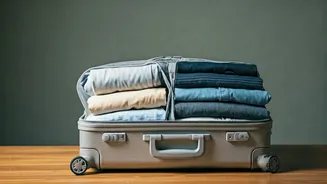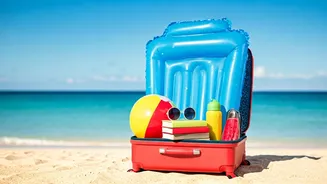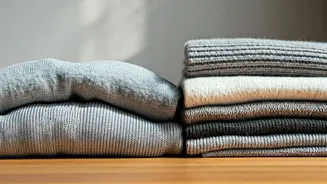The Roll Method
The roll method is a tried-and-true packing technique lauded for its space-saving capabilities and wrinkle reduction. This method involves rolling clothes
tightly, which compresses them and minimizes creases. To roll effectively, lay the garment flat and fold in the sleeves if necessary. Start rolling from the bottom edge towards the top, creating a compact cylinder. This method is particularly useful for t-shirts, jeans, and casual wear. The rolled clothes can then be arranged tightly within the luggage, maximizing space utilization. Consider using packing cubes to further organize and compress the rolled items. The roll method is also beneficial for preventing wrinkles, as the tight rolling action keeps the fabric taut and reduces the chance of creasing. Furthermore, this method allows for easy identification of specific items within the suitcase, eliminating the need to unpack the entire bag to find something. The roll method is a practical and efficient choice for maximizing luggage space while maintaining the condition of your garments during travel.
The Bundle Method
The bundle method provides a structured approach to packing by creating a central core around which other items are wrapped. Begin by laying the core items, such as shoes or toiletries, at the center of the suitcase. Then, place items like pants and skirts around the core, with the legs and hems extending outward. Shirts and blouses are then laid on top, with the sleeves draped over the edges. Fold the edges of the garments toward the center, creating a neat bundle. This method not only saves space but also keeps clothes relatively wrinkle-free. The bundle method is excellent for preventing clothes from shifting during transit and can be especially useful for delicate fabrics. By wrapping clothes around a central core, you create a cohesive and compact packing structure. Consider using packing cubes to further organize the items within the bundle. The bundle method also aids in weight distribution, ensuring a balanced load and making the suitcase easier to manage. This approach offers a smart solution for organized and efficient packing.
The KonMari Fold
The KonMari method, popularized by Marie Kondo, emphasizes folding clothes in a way that allows them to stand upright. Start by laying the garment flat. Fold the garment lengthwise, bringing the sleeves or sides to the center. Then, fold the garment in half or thirds, depending on its size and thickness. The goal is to create a compact, rectangular shape that can stand on its own. This method is excellent for maximizing drawer or shelf space, and it makes it easy to see and access all your clothes. The upright positioning of folded items allows you to see everything at a glance, eliminating the need to dig through piles of clothes. The KonMari fold is particularly effective for t-shirts, pants, and other items that can be neatly arranged. Additionally, the method encourages you to assess your wardrobe, discard unnecessary items, and embrace a minimalist approach. This method will make packing a more enjoyable and organized experience.
Folding for Shirts
Folding shirts effectively is crucial for preventing wrinkles. Button the shirt and lay it face down. Fold one sleeve across the back, then fold the opposite sleeve over the first. Fold the shirt in half vertically, from the bottom to the collar. Alternatively, you can fold the shirt into thirds, bringing the sides toward the center and then folding in half. For dress shirts, consider using tissue paper or shirt boards to maintain their shape and prevent creases. Shirts should be packed on top of heavier items, or in a separate compartment to avoid compression. Always consider the fabric of the shirt; wrinkle-resistant fabrics are easier to pack than delicate ones. Choose a method that is simple and works for the type of shirt you're packing, ensuring a neat and tidy result when you unpack. The right folding technique enhances the shirts' appearance.
Packing Pants Right
Properly folding pants minimizes wrinkles and maximizes space. Lay the pants flat, with the front side facing down. Fold the pants in half lengthwise, bringing one leg over the other. Then, fold the pants in half or thirds, depending on the length and the space available. For jeans and heavier pants, folding in half might suffice, while lighter fabrics might benefit from a trifold. Consider the type of pants; dress pants require more careful folding compared to casual pants. Place pants at the bottom of the suitcase to provide a base for other items. Use packing cubes for further organization and compression, especially if you're carrying multiple pairs. Carefully consider the fabric type and pack accordingly. Following these methods ensures that your pants arrive at your destination in good condition.
Suitcase Placement Techniques
Organizing items within a suitcase impacts efficiency and convenience. Heavier items, such as shoes and toiletries, should be placed at the bottom, closest to the wheels, to provide a stable base and prevent the suitcase from tipping over. Pants and skirts can be laid on top of heavier items, creating a flat surface for other clothes. Shirts should be packed on top of pants, or in a separate compartment. Shoes can be placed in shoe bags to protect other items and maintain cleanliness. Utilize packing cubes to separate different types of garments and maximize space utilization. Delicate items, such as jewelry, should be packed in a designated compartment or travel jewelry case. Ensure that frequently used items, like toiletries or a change of clothes, are easily accessible. Consider the suitcase's internal structure and adjust your packing methods. The strategic placement of items in your suitcase significantly enhances the packing process.
Using Packing Cubes
Packing cubes provide a game-changing method for organizing and compressing clothes. Place items into separate cubes based on type or outfit, and then compress the cubes to save space and minimize wrinkles. Cubes are particularly useful for separating clean and dirty clothes, making it easier to manage laundry on the go. They come in various sizes, allowing for tailored organization. Using packing cubes creates structure within the suitcase, preventing items from shifting during transit. This method also protects clothes from spills or damage. Consider using different colored cubes to differentiate between various types of clothing. The use of packing cubes greatly improves the organization of your luggage. Packing cubes are a valuable tool for any traveler seeking an organized and efficient packing system, and significantly enhance space management.
Dealing with Wrinkles
Wrinkles are a common travel concern, but several techniques can mitigate their appearance. Choose wrinkle-resistant fabrics like jersey, nylon, or polyester. When packing, avoid overstuffing the suitcase, which can cause excessive creasing. Utilize folding methods that minimize wrinkles, such as rolling or the KonMari fold. Hang clothes as soon as you arrive at your destination to allow wrinkles to release naturally. If wrinkles persist, use a travel-sized steamer or iron, or utilize the hotel's iron facilities. Consider using wrinkle-release sprays to loosen fabric and make ironing easier. Pack clothes in garment bags, especially for delicate items like suits or dresses. Taking these steps will help you arrive at your destination with your clothes ready to wear.













